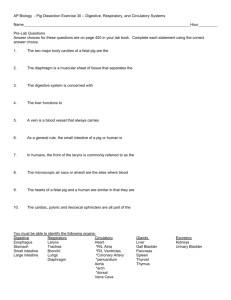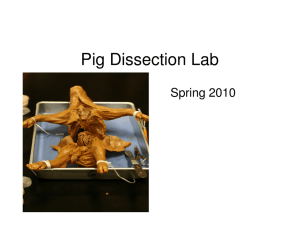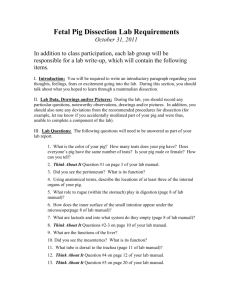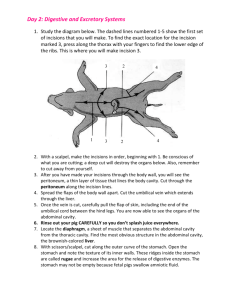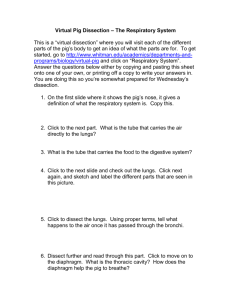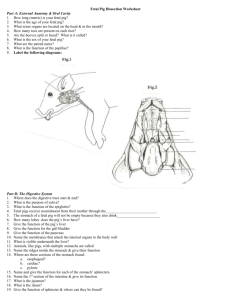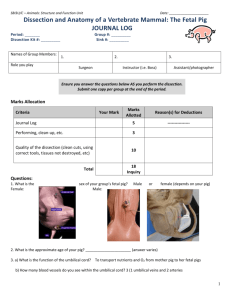Dissection of the Fetal Pig
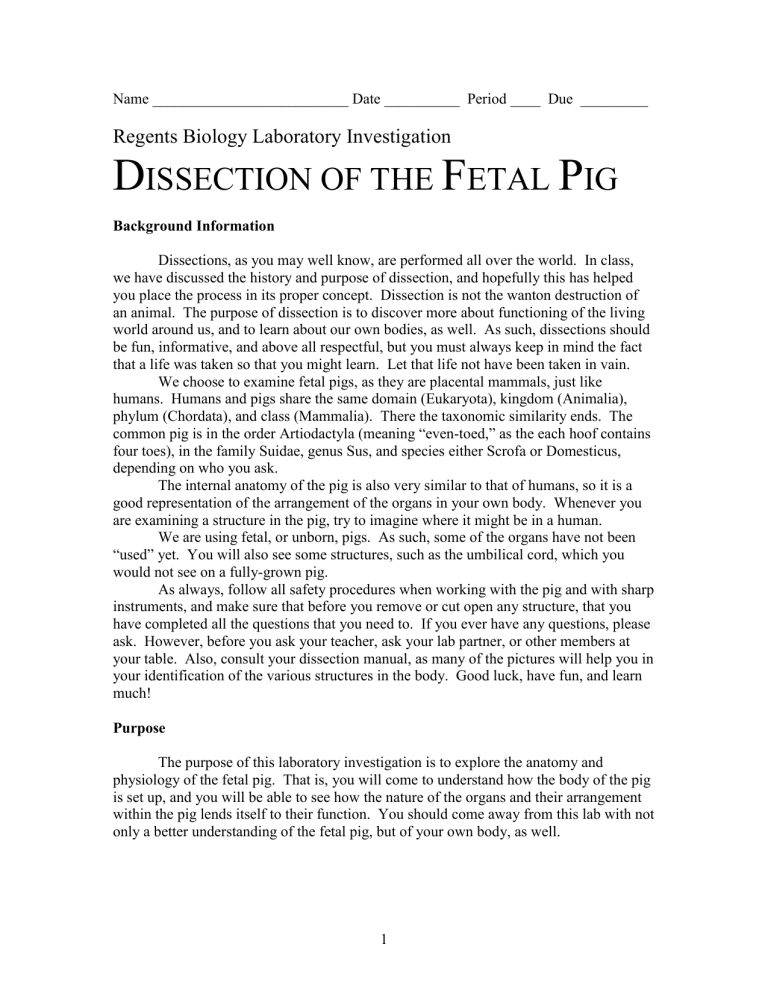
Name __________________________ Date __________ Period ____ Due _________
Regents Biology Laboratory Investigation
D
ISSECTION OF THE
F
ETAL
P
IG
Background Information
Dissections, as you may well know, are performed all over the world. In class, we have discussed the history and purpose of dissection, and hopefully this has helped you place the process in its proper concept. Dissection is not the wanton destruction of an animal. The purpose of dissection is to discover more about functioning of the living world around us, and to learn about our own bodies, as well. As such, dissections should be fun, informative, and above all respectful, but you must always keep in mind the fact that a life was taken so that you might learn. Let that life not have been taken in vain.
We choose to examine fetal pigs, as they are placental mammals, just like humans. Humans and pigs share the same domain (Eukaryota), kingdom (Animalia), phylum (Chordata), and class (Mammalia). There the taxonomic similarity ends. The common pig is in the order Artiodactyla (meaning “even-toed,” as the each hoof contains four toes), in the family Suidae, genus Sus, and species either Scrofa or Domesticus, depending on who you ask.
The internal anatomy of the pig is also very similar to that of humans, so it is a good representation of the arrangement of the organs in your own body. Whenever you are examining a structure in the pig, try to imagine where it might be in a human.
We are using fetal, or unborn, pigs. As such, some of the organs have not been
“used” yet. You will also see some structures, such as the umbilical cord, which you would not see on a fully-grown pig.
As always, follow all safety procedures when working with the pig and with sharp instruments, and make sure that before you remove or cut open any structure, that you have completed all the questions that you need to. If you ever have any questions, please ask. However, before you ask your teacher, ask your lab partner, or other members at your table. Also, consult your dissection manual, as many of the pictures will help you in your identification of the various structures in the body. Good luck, have fun, and learn much!
Purpose
The purpose of this laboratory investigation is to explore the anatomy and physiology of the fetal pig. That is, you will come to understand how the body of the pig is set up, and you will be able to see how the nature of the organs and their arrangement within the pig lends itself to their function. You should come away from this lab with not only a better understanding of the fetal pig, but of your own body, as well.
1
Materials
You will need one set of materials for each pair of students. You should each, however, have your own PENCIL.
Preserved fetal pig Scalpel
Ruler Gloves (optional)
Dissecting pan
Probe
Light microscope Slide
Dissecting pins
Procedure
Dissecting manual
Cover glass
PENCIL
PART I – EXTERNAL ANATOMY
String
Forceps
Scissors
Tags
In order to find your way around the pig, you must orient yourself with the layout of its body. We will need to have a common language when discussing the location of various structures. There are, as such, a few terms and concepts with which you must be familiar in order to properly conduct your dissection. Refer to figure 1 for a pictorial representation of the table below. You should also note that if the terms “right” or “left” are used, they refer to the pig’s right or left, not the observer’s.
Term Definition
Anterior
Posterior
Ventral
Dorsal
Transverse Section
Sagital Section
Lateral
Port
Starboard
Towards the mouth
Towards the anus
The stomach side
The back side
A slice of the specimen from dorsal to ventral
A slice of the specimen from anterior to posterior
To either side
Left side
Right side
Table 1. Terms to know for a successful dissection.
1. Examine the outside of your pig. Look for any features that you didn’t expect to find, or whose function you don’t understand.
QUESTION 1: List some external features of your pig, including those which confuse you at this point.
2. You can get a rough estimate on the age of your pig based on its length. You should use a ruler, or a piece of string that you can measure later, and measure from the tip of the snout to the base of the tail.
2
7 Weeks: 28 mm
8 Weeks: 40 mm
15 Weeks: 220 mm
17 Weeks: 300 mm (birth length)
QUESTION 2: What is the approximate age of your fetal pig?
Figure 1. Picture of terms to know for a successful dissection.
3. The sex of your pig is easily determined by examining external structures.
Both male and female pigs will have nipples on the ventral side, so this feature cannot be used to determine sex. In males, the scrotal sac, which contains the testes, is located beneath the anus. The urogenital opening of the male is just posterior of the umbilical cord on the ventral surface. The female urogenital opening is beneath the anus, and females will, of course, lack a scrotum.
QUESTION 3: What is the sex of your pig? Make sure to examine a pig of the opposite sex to familiarize yourself with both sexes.
4. Examine the umbilical cord. If you look at the cut end, you may be able to see two arteries and one vein. If you cannot, use your scissors to cut off about 1 cm, and examine the freshly-cut end.
QUESTION 4: In the space below, draw a cross section of the umbilical cord. Label the arteries and vein.
3
5. Examine the feet of the pig. Recall the pig’s taxonomical order, and see if you can relate the meaning of it to what you are seeing.
QUESTION 5: How many toes does the pig have, and how are they arranged?
QUESTION 6: Do you notice any hair or varying colorations on the skin of your pig?
What do you think the hair is for, and what caused the color differences?
PART II – PRIMARY INCISION
The first incision that you make will no doubt be the most difficult, as you will be unsure of how deep to cut, or where to start and stop your incisions. Don’t worry too much; you will be surprised at how tough the skin and muscles are. It behooves you, therefore, to cut carefully until you know about how thick the various layers are.
You will be able to feel the ribs in the thorax, and those can guide you as to how deep to cut, but on the abdomen, proceed slowly so that you do not cut into any internal organs.
Figure 2. Primary incisions (numbers indicate the order in which incisions should be made)
1. Tie a piece of string around one of the pig’s front feet. Loop the string under your pan, and tie it to the other front foot. You will have to apply considerable pressure in order to move the front legs; do not worry about breaking any bones, but do not over extend the legs, either.
2. Secure the hind legs in the same manner. If you find that your string is too long, you can tie a knot in it to make it shorter.
3. When you are done for the day, you can leave the strings on your pig; simply un-loop them from under the pan. You do not have to tie new strings each day.
4
4. When you have secured your pig, make your incisions as shown in figure 2.
Your goal is to make two lateral “flaps” that you can pin back to expose the abdomen.
When cutting towards the anterior side on the neck, do not cut too deeply; there are structures that are much closer to the skin here. Start at the dot on line 1.
5. Once you have made your incisions, begin to pull back the flaps you have created. You will notice that many internal structures are attached to the inside of the body wall. Use a scalpel to carefully trim these as close to the body wall as possible.
6. The diaphragm, the muscle that expands and contracts to ventilate the lungs, will be readily visible under the two flaps on the abdomen. Observe this muscle before cutting it in order to pin back the flaps.
7. Slowly pull back the flap with the umbilical cord on it. You will be able to see the umbilical vessels extend from the cord up through the liver, towards the anterior side of the pig. You will also note the umbilical arteries, which will be lighter, and attached to the flap.
Sever these arteries and veins. Do not remove the flap.
8. The internal organs are covered by a layer of membrane called the peritoneum. This may have been pulled away when you opened the abdominal cavity, or it may still be present. If it is, carefully slice it open and move it to the side.
9. You will note many internal organs at this point, some of which are labeled in figure 3. There is further connective tissue holding these organs in place, called mesentery.
Figure 3. Primary view of abdominal cavity
PART III – DIGESTIVE ORGANS OF THE ABDOMEN
1. You will note that the liver is the dominant organ visible. This size and prominence speaks to the liver’s varied and important functions in the body. Examine also the intestines, and see if you can differentiate between the small and large intestines.
QUESTION 7: Upon examining the small and large intestines, make a sketch of each below, and note the differences that you observe.
5
2. The liver has many different lobes. On the dorsal side of one lobe, you will find the gallbladder, a lighter-colored sac which holds bile. Find the common bile duct where it exits the gallbladder, and trace it until in enters the duodenum.
QUESTION 8. How many lobes does the liver have?
QUESTION 9. Describe the location and appearance of the gallbladder.
QUESTION 10. Describe the route of the common bile duct. Did any other ducts join it? Even if you didn’t see it, what other duct should have joined the common bile duct?
3. If you have answered all the questions on the liver, you may remove it. You will find that it is attached at many points, and that there is one, large blood vessel at the back. This is the hepatic artery, which branches and eventually leads into the hepatic portal vein. Because your pig has been drained of blood and injected with a blue latex, if you remove the liver tissue surrounding the hepatic portal system, you should be able to see the highly-branched network of capillaries that feed the liver.
4. Using your scalpel or a razor blade, gently scrape away the liver tissue from one lobe of the liver. You will be left with a blue latex outline of the hepatic portal system, the system of vessels that feeds the liver.
QUESTION 11: Why do you think the liver has such a highly-branched system of vessels?
5. Upon removal of the liver, you should be able to see the stomach. It is a large, brownish sac on the left side of the pig.
QUESTION 12: Trace the esophagus as it leads away from the stomach. Can you trace it very far? Why or why not?
QUESTION 13. Describe the path that the esophagus takes to get from the stomach to the pharynx.
6
6. Cut open the stomach with an incision from the fundus (esophageal side) to the pylorus (intestinal side). If you need to, you may rinse out the stomach by using a dropper filled with clean water, and squirting any material out of the way. N.B. – if you wish to dispose of this material, do not do so in a drain. Put it in the garbage can.
7. Examine the interior of the stomach, as well as the cut side of it that you can see.
QUESTION 14. Was the material that you found in the stomach food? Explain why or why not. Also explain the function of the umbilical cord vessels.
QUESTION 15. The stomach has two sphincters. One, the cardiac sphincter, is between the esophagus and the stomach. The other, the pyloric sphincter, is between the stomach and the duodenum. What are the functions of these two sphincters?
QUESTION 16: One of these sphincters is weaker than the other, and, if the contents of the stomach must be moved out because of bacteria or other contamination, it will open to allow this to happen. Which sphincter is this, and why?
QUESTION 17: Feel the inside of the stomach, and examine the cut edges. Describe your findings, and make a hypothesis as to how what you felt and saw helps the stomach with its job.
8. The pancreas will be located under the stomach. It is lighter than the stomach, and has a pebbled or granular-looking surface.
9. The pancreatic duct may be visible on the surface of the pancreas, and you may be able to trace it to where it joins the duodenum.
7
QUESTION 18: What is the function of the pancreas?
10. Locate the small intestine. Examine its outer appearance. Note the mesentery that holds the coils together. You can unfold a few of these coils and find some of the nerves and blood vessels that feed and innervate the small intestine.
11. At the juncture of the small and large intestines, locate a small sac called the caecum. This is a structure that holds bacteria to digest cellulose and other indigestible foods that the pig may eat. Humans do not have a caecum, instead, we have an appendix which is thought to be a vestigial structure that evolved from the caecum.
12. Locate the large intestines, and unfold a few coils. Note the difference in external appearance from that of the small intestine.
QUESTION 19: Compare and contrast the external appearance of the small and large intestines.
13. If you have examined the small intestine and stomach, you may remove them.
Carefully cut the esophagus as close to the stomach as you can, and cut the small intestine where it joins the large intestine. There will be much mesentery and other connecting blood vessels that you will need to trim away. Cut slowly, so as not to destroy the structures that lie below the digestive tract.
14. Once you have removed the small intestine and stomach, cut the stomach away from the small intestine. Measure the small intestine. Take a small cross-section of the small intestine. This is best done by slicing out a 4-5 cm section, placing a probe through the lumen of the intestine, and cutting a very, very thin section of the intestine off one end.
QUESTION 20: What is the length of the small intestine, in centimeters?
15. Prepare a wet mount of this section, and examine it under low power.
QUESTION 21: What structures can you see on the inner lining of the small intestine?
What is their purpose?
QUESTION 22: Draw the small intestine as it appears under low power.
8
16. If you have answered all the questions on the stomach and small intestines, you can discard them in the garbage can.
17. Remove the large intestine as well. Leave 3-4 cm of the large intestine, to aid you with further dissection later. Examine the large intestine’s exterior and interior, and note the relative length of the small intestine as compared with the large intestine.
QUESTION 23: How does the inside of the large intestine compare to that of the small intestine? Why might this be?
18. You may dispose of the large intestine in the garbage can. If you need to, you may rinse out the abdominal cavity of your pig with a dropper and clean water. Do not dispose of any material down the drain. Put it in the garbage can.
PART IV – THE URINARY ORGANS OF THE ABDOMEN
1. You should be able to see two bean-shaped sacs towards the posterior side of the abdominal cavity. These are the kidneys.
2. You will also see two large vessels running down the dorsal side of the pig.
One, an artery, is the aorta. The other, a vein, is the inferior vena cava. Branches from each of these vessels feed the kidneys. Be careful not to destroy these structures.
3. If there is a layer of peritoneum on top of one of the kidneys (leaving the other untouched), carefully cut it away. You will see the renal arteries and veins that branch from the aorta and inferior vena cava. You will also notice a thin-ish, translucent-white tube that leads from the kidneys to the bladder. The bladder will be on the flap that contains the umbilical cord. This is the ureter. There is one per kidney. You will also see a lighter lump of grainy tissue on top of the kidney
QUESTION 24: What is the structure on the anterior side of the kidney? What is its purpose?
4. Remove one of the kidneys and make a longitudinal section of it. You should be able to see three, distinct layers: the cortex, medulla, and pelvis.
QUESTION 25: Draw and label the sectioned kidney below.
9
PART V – THE REPRODUCTIVE ORGANS OF THE ABDOMEN
1. In order to expose the organs of the reproductive system, it will be necessary to further expose the pelvic region of the pig with another incision. Begin slightly to one side of the umbilical cord, and continue to just before the anus. You will need to carefully move aside or cut through the cartilage and muscle of the lower pelvic region.
See figures 4 and 5 for details of both male and female pigs.
2. In female pigs, the ovaries will be located just posterior to the kidneys. They are small, light-ish, and bean-shaped. The oviducts or fallopian tubes will extend off of the ovaries, and down to the horn of the uterus.
The vagina extends from the uterus, and exits the body in the urogenital opening, just anterior of the anus.
The bladder and the vagina share the same, exterior opening.
3. In male pigs, the testes may or may not be visible externally.
They develop inside the fetus, and descend as it develops. Depending on the age of your pig, they may not be fully descended. The opening in the wall of the Figure 4. Female reproductive anatomy abdomen through which the testes descend is called the inguinal canal. You will note the epididymis on the posterior side of each testis. This is the organ that stores and matures sperm. The sperm duct, continuous with the epididymis, carries sperm up through the abdominal wall, into the urethra.
4. If you have a female pig, look under where you removed the kidney for an ovary. Trace the path that an egg would take from the ovary to the uterus.
5. If you have a male pig, carefully open one of the scrotal sacs (if the testes are descended), or locate the testes in the body, and identify the testis, epididymis, and sperm duct. Follow the sperm duct to where it joins the urethra.
6. MAKE SURE that you examine a pig of the opposite sex, and make sure that you can identify all the necessary organs.
10
QUESTION 26: Pigs are placental mammals, just like humans are. Explain what this means
Figure 6. Male reproductive anatomy.
QUESTION 27: The male and female reproductive systems initially start off the same.
A gene for “maleness” starts the development of male organs, but in the absence of this gene, the organs continue to develop as female. Make some comparisons between the structures in the two systems, and make some conjectures as to which pairs of organs might have developed from the same tissues.
PART VI – THE ORGANS OF THE THORAX
We have completed our examination of the organs of the abdomen, and we now move up to the thorax, or chest cavity. The ribs cover and protect the thorax, and will present you with some difficulty in observing the organs contained therein. In order to see the heart and lungs, you will need to pull back the rib cage on either side. This may take some effort. Dissection pins can then be used to hold down these flaps. Do not attempt to cut the ribs.
11
1. You will note that there may be some membranes covering the lungs or heart.
The plural membrane covers the lungs, and the pericardium covers the heart. You will need to gently move these membranes aside.
2. Note also that the diaphragm forms a separation between the thorax and abdomen. The diaphragm contracts and relaxes to raise and lower the pressure in the thorax, which ventilates the lungs.
3. The lungs are two structures to port and starboard of the heart.
QUESTION 28: How many lobes does the right lung have? The left lung? What could account for any difference you might find?
QUESTION 29: Does the fetus use its lungs? Explain.
4. Move the lungs aside and examine the heart. The heart is enclosed by the pericardium, a fluid-filled sac. This cushions the heart, preventing it from bashing itself against the ribs.
5. The anterior side of the heart is covered by the thymus gland. The thymus is a crucial organ of the immune system, helping to mature T-cells. Indeed, the “T” in T-cells stands for thymus.
QUESTION 30: Describe the position and appearance of the thymus gland.
6. Remove the thymus, and cut away any remaining pericardium. Gently lift up the posterior side of the heart to examine the vessels underneath it.
QUESTION 31: Draw the heart as it appears in the chest. Label the right and left ventricles, superior and inferior vena cavae, right and left atria, aorta, and coronary arteries and veins. Use your dissection manual to guide you in your labeling.
Remember, right and left refer to the pig’s right and left, not yours.
12
7. The ductus arteriosus shunts blood from the pulmonary artery to the aorta, bypassing the lungs almost completely. Identify this structure in the pig.
QUESTION 32: Why does the ductus arteriosus exist? What do you think happens to it shortly after birth?
8. In order to remove the heart, you will need to cut the blood vessels that connect it to the body. When cutting these vessels, cut them as FAR AWAY from the heart as you can. It is your goal to leave as much of the vessels on the heart as possible, to aid you in identifying the chambers and structures of the heart when it is removed from the body.
9. With the heart removed from the body, examine the dorsal side, which was not previously visible.
10. Make a sagittal section of the heart, so that the heart opens much like a book.
Your incision should be parallel to the dorsal and ventral sides of the heart.
QUESTION 33: Draw the sectioned heart below. Use your dissection manual to help you label the ventricles and atria, as well as the aorta. You may have cut through the valves of the heart when sectioning it. If they are visible, label the valves between the atria and the ventricles, and the valve between the left ventricle and the aorta.
11. If you are done sketching the heart, you may dispose of it in the garbage can.
The trachea should be readily-visible with the heart removed, and is easily identified by its rings of cartilage. Dorsal to the trachea, lies the esophagus.
QUESTION 34: Why do you think the trachea has cartilage rings, and the esophagus does not?
13
12. The carotid arteries and veins lie to either side of the neck, and carry blood to and from the head and brain.
13. The thyroid gland lies ventral to the trachea. It may have been damaged or partially-removed when the neck was opened. Identify it, as well s the larynx, which is a bulge at the top of the trachea.
PART VII – THE ORGANS OF THE HEAD
In order to further examine the organs of the head, it will be necessary to remove some skin from the face. It is important to note here that the skin and musculature of the face are much different, and usually thinner, than that of the abdomen and thorax. Use care when dissecting around the face.
1. Use Figure 7 and your dissection manual as guides, and remove a triangle of skin from the face. Locate the salivary glands, and ducts you might see leading from them to the mouth cavity.
QUESTION 35: Describe the salivary glands.
2. In order to examine the upper portion of the digestive tract, it will be necessary to open the pig’s mouth. Use Figure 6. Opened mouth of fetal pig. caution, as the teeth, although small, can be very sharp. It will be necessary to cut the muscles along the side of the mouth to open it further, and you may choose to cut the jaw bone using scissors to further extend the lower jaw. This creates a sound which is unpleasant to some students, so please use caution.
3. Use figure 6 to identify the structures at the back of the mouth.
QUESTION 36: What is the purpose of the epiglottis?
Figure 7. Incision for exposing the salivary glands.
14
PART VIII – THE CENTRAL NERVOUS SYSTEM
1. The nervous system of the pig is very similar to that of humans. In order to access the primary organs of the nervous system, the brain and the spinal cord, you will need to open the cranium. This can be done by making a dent in the top center of the head with your scissors, and then using the scissors to cut away the rest of the skull.
Always keep the tips of your scissors pointed up to avoid damaging the brain.
2. Your goal is to remove the dorsal part of the skull, and portions of it on the back of the head. You will also need to expose the spine by making an incision over it, and removing the skin and muscle around it.
QUESTION 37: Why are the brain and spinal cord so well-protected? Is it just to foil bio students’ attempts at dissection?
3. The meninges are the covering of the brain and spinal cord. You may be able to see all three of the layers, the dura mater, arachnae, and pia mater. These membranes protect the brain from infection, and are filled with fluid to protect it from shock.
Meningitis is a very dangerous disease resulting from the infection of these membranes.
4. Once you have exposed the brain and the spinal cord, use your dissection manual to make a labeled drawing in question 38. You may not be able to see all the structures listed, so only label what you actually see!
5. Locate some of the nerves that come off of the spinal cord, and use your dissection manual to determine what they might do.
6. You may remove the brain if you wish, by removing more of the skull, and carefully prying out the brain. Note that the optic nerves and many other connections must be carefully severed before removing the brain.
QUESTION 38: Make a drawing of the brain below. Use your dissection manual to label as many parts as you can.
QUESTION 39: Describe the appearance of the spinal cord.
15
QUESTION 40: What areas of the pig’s brain would you expect to be more welldeveloped than in a human? Why?
QUESTION 41: List any difficulties that you had with this lab, and what might have made it easier for you. You must list at least two items.
7. You have completed your dissection! If you wish, you may go back and use your dissection manual to examine other structures, or further examine structures for more details. Remember, you will be expected to be able to identify and describe the function of any structure in this lab on your lab practical.
8. To dispose of your pig, return it to the bucket whence it came. The specimens will be disposed of safely.
16

